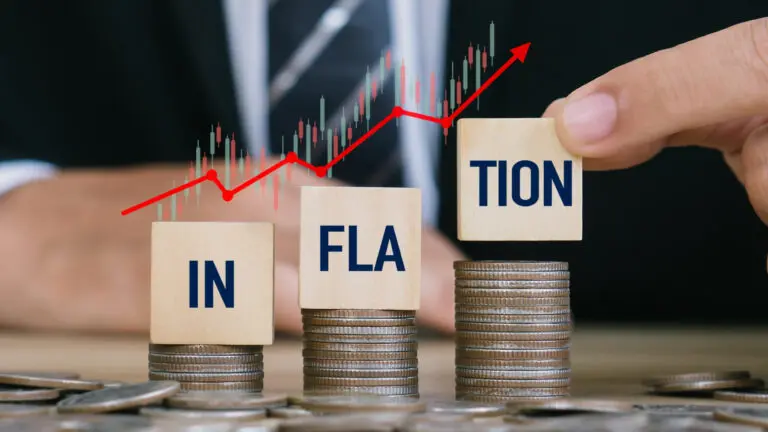
NOVEMBER INFLATION MODERATES AFTER OCTOBER HIGH
After touching a 14-month high level of 6.21% in October 2024; CPI inflation was is back at 5.48% in November 2024. That is where inflation was in September. Even prior to the data announcement, Bloomberg consensus estimate had pegged consumer inflation in November at well under 5.5%. The actually November 2024 CPI inflation at 5.48% was largely in line with the street expectations. There are two points to note here. Firstly, the lower inflation is largely on account of the base effect. Base year inflation between October 2023 and November 2023 was sharply up from 4.87% to 5.55%. This largely explains the fall in yoy headline inflation in November 2024. Secondly, the 183 bps fall in food inflation in November 2024 is also largely on account of the base effect wherein the food inflation had gone up from 6.61% to 8.70% between October and November 2023. One broad concern is that the core inflation remains elevated around the 3.70%, at par with previous month.
FOOD INFLATION MODERATES; CORE INFLATION FLAT
The headline inflation is broadly divided into food inflation, fuel inflation and core inflation. Core inflation is the residual inflation net of food and fuel. The table has 13 months data.
| Month | Food Inflation (%) | Core Inflation (%) | Headline Inflation (%) |
| Nov-23 | 8.70% | 4.11% | 5.55% |
| Dec-23 | 9.53% | 3.89% | 5.69% |
| Jan-24 | 8.30% | 3.59% | 5.10% |
| Feb-24 | 8.66% | 3.37% | 5.09% |
| Mar-24 | 8.52% | 3.24% | 4.85% |
| Apr-24 | 8.70% | 3.23% | 4.83% |
| May-24 | 8.69% | 3.12% | 4.80% |
| Jun-24 | 9.36% | 3.14% | 5.08% |
| Jul-24 | 5.42% | 3.39% | 3.60% |
| Aug-24 | 5.66% | 3.40% | 3.65% |
| Sep-24 | 9.24% | 3.51% | 5.49% |
| Oct-24 | 10.87% | 3.70% | 6.21% |
| Nov-24 | 9.04% | 3.70% | 5.48% |
Data Source: MOSPI & Ministry of Finance Estimates
Here are some key takeaways from the table above.
Let us now break up the non-food and the food inflation into rural and urban inflation to understand where is the trigger for inflation shifts coming from.
NON-FOOD INFLATION: URBAN STORY VERSUS RURAL STORY
Let us first look at the macro picture of rural and urban inflation. Between October 2024 and November 2024, the headline inflation moderated from 6.21% to 5.48%. During this period, headline rural inflation fell from 6.68% to 5.95%, while headline urban inflation also fell from 5.62% to 4.83%. What about the break-up of food inflation? Between October 2024 and November 2024, the food inflation moderated from 10.87% to 9.04%. However, rural food inflation fell from 10.69% to 9.10%, while urban food inflation also fell from 11.09% to 8.74%. Food inflation appears to have considerably moderate in urban India in Nov-24.
| Non-Food Basket |
Non-Food Weights |
Rural Inflation |
Urban Inflation |
Headline Inflation |
| Clothing | 6.32 | 2.88 | 2.76 | 2.83 |
| Footwear | 1.04 | 1.90 | 2.57 | 2.14 |
| Clothing and footwear | 7.36 | 2.74 | 2.74 | 2.75 |
| Housing | – | – | 2.87 | 2.87 |
| Fuel and light | 7.94 | -0.88 | -3.53 | -1.83 |
| Household goods and services | 3.75 | 2.42 | 3.31 | 2.82 |
| Healthcare | 6.83 | 3.86 | 4.19 | 4.01 |
| Transport and communication | 7.60 | 2.85 | 2.41 | 2.64 |
| Recreation and amusement | 1.37 | 2.61 | 2.68 | 2.65 |
| Education | 3.46 | 3.67 | 4.10 | 3.89 |
| Personal care and effects | 4.25 | 10.34 | 10.54 | 10.42 |
| Miscellaneous | 27.26 | 4.33 | 4.24 | 4.26 |
Data Source: MOSPI & Ministry of Finance Estimates
Where is rural India scoring on inflation and where is urban India scoring on the inflation story? One of the major items where there is a huge gap is fuel and lighting. In this case, while the overall fuel & light inflation is at -1.83%, the urban inflation stands at -3.53% while rural inflation is -0.88%. Even the transport and communication inflation is higher in rural areas at 2.85% compared to 2.41% in urban India. However, rural inflation has been lower in items like footwear, household goods, healthcare, and personal care & effects. It is rural India that is scoring much better on the core inflation basket.
FOOD BASKET: HOW RURAL AND URBAN INDIA STACKED UP?
Food basket with a weightage of 47.25% continues to be the swing factor for inflation since mid-2023; and November 2024 was no exception. The food basket is also broken into rural and urban inflation to assess the granular impact.
| Food Basket |
Food Weights |
Rural Inflation |
Urban Inflation |
Headline Inflation |
| Cereals and products | 12.35 | 7.20 | 6.13 | 6.88 |
| Meat and fish | 4.38 | 4.74 | 4.64 | 4.67 |
| Egg | 0.49 | 4.67 | 5.08 | 4.84 |
| Milk and products | 7.72 | 2.74 | 3.02 | 2.85 |
| Oils and fats | 4.21 | 14.88 | 10.27 | 13.28 |
| Fruits | 2.88 | 9.22 | 6.08 | 7.68 |
| Vegetables | 7.46 | 30.02 | 28.13 | 29.33 |
| Pulses and products | 2.95 | 5.72 | 4.83 | 5.41 |
| Sugar and Confectionery | 1.70 | 1.08 | 1.76 | 1.31 |
| Spices | 3.11 | -7.93 | -6.42 | -7.43 |
| Non-alcoholic beverages | 1.37 | 2.31 | 3.43 | 2.72 |
| Prepared meals | 5.56 | 3.51 | 4.46 | 3.95 |
| Food Basket | 47.25 | 9.10 | 8.74 | 9.04 |
Data Source: MOSPI & Ministry of Finance Estimates
Here are the key items in the inflation basket across rural and urban segments.
If the vegetables basket is ignored, overall inflation would be just about 3.9%, which is well within the RBI mandate. Clearly, vegetables continues to be the big problem area for RBI.
DO WE SEE RATE CUT CHANCES IN FEBRUARY 2025?
These are early days and it may not help much to second-guess what the RBI will do. After the RBI maintained status quo in December, it looks like there may be a pause in February 2025 also. Possibly, the CRR may be cut by another 50 bps to handle liquidity shortages, but rate cuts amidst 5.48% inflation looks tough. RBI would be worried about two things. Firstly, the fall in inflation in November is largely on account of the base effect and it needs to be seen how inflation behaves shorn of the base effect. Also, core inflation remains sticky at 3.7% and the RBI may prefer much lower levels before a rate cut.
One hint from the RBI has been that India has to live with a new normal for rates, which is higher than the previous normal. So, 135 bps higher repo rates may be par for the course. RBI may want to avoid a situation where inflation spikes and it does not have enough choices on hand. Of course, that is a choice that the new RBI Governor, Sanjay Malhotra has to make!
Related Tags

![]() IIFL Customer Care Number
IIFL Customer Care Number
(Gold/NCD/NBFC/Insurance/NPS)
1860-267-3000 / 7039-050-000
![]() IIFL Capital Services Support WhatsApp Number
IIFL Capital Services Support WhatsApp Number
+91 9892691696
IIFL Capital Services Limited - Stock Broker SEBI Regn. No: INZ000164132, PMS SEBI Regn. No: INP000002213,IA SEBI Regn. No: INA000000623, SEBI RA Regn. No: INH000000248, DP SEBI Reg. No. IN-DP-185-2016, BSE Enlistment Number (RA): 5016
ARN NO : 47791 (AMFI Registered Mutual Fund Distributor), PFRDA Reg. No. PoP 20092018

This Certificate Demonstrates That IIFL As An Organization Has Defined And Put In Place Best-Practice Information Security Processes.